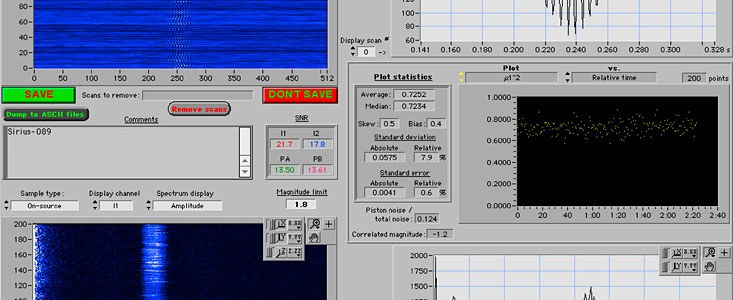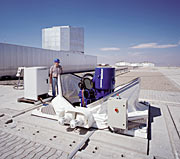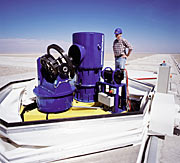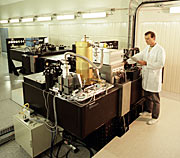Press Release
"First Light" for the VLT Interferometer
Excellent Fringes From Bright Stars Prove VLTI Concept
18 March 2001
Following the "First Light" for the fourth of the 8.2-metre telescopes of the VLT Observatory on Paranal in September 2000, ESO scientists and engineers have just successfully accomplished the next major step of this large project.
On March 17, 2001, "First Fringes" were obtained with the VLT Interferometer (VLTI) - this important event corresponds to the "First Light" for an astronomical telescope. At the VLTI, it occurred when the infrared light from the bright star Sirius was captured by two small telescopes and the two beams were successfully combined in the subterranean Interferometric Laboratory to form the typical pattern of dark and bright lines known as "interferometric fringes". This proves the success of the robust VLTI concept, in particular of the "Delay Line".
On the next night, the VLTI was used to perform a scientific measurement of the angular diameter of another comparatively bright star, Alpha Hydrae (Alphard); it was found to be 0.00929±0.00017 arcsec. This corresponds to the angular distance between the two headlights of a car as seen from a distance of approx. 35,000 kilometres. The excellent result was obtained during a series of observations, each lasting 2 minutes, and fully confirming the impressive predicted abilities of the VLTI.
This first observation with the VLTI is a monumental technological achievement, especially in terms of accuracy and stability. It crucially depends on the proper combination and functioning of a large number of individual opto-mechnical and electronic elements. This includes the test telescopes that capture the starlight, continuous and extremely precise adjustment of the various mirrors that deflect the light beams as well as the automatic positioning and motion of the Delay Line carriages and, not least, the optimal tuning of the VLT INterferometer Commissionning Instrument (VINCI).
These initial observations prove the overall concept for the VLTI. It was first envisaged in the early 1980's and has been continuously updated, as new technologies and materials became available during the intervening period. The present series of functional tests will go on for some time and involve many different configurations of the small telescopes and the instrument. It is then expected that the first combination of light beams from two of the VLT 8.2-metre telescopes will take place in late 2001.
According to current plans, regular science observations will start from 2002, when the European and international astronomical community will have access to the full interferometric facility and the specially developed VLTI instrumentation now under construction. A wide range of scientific investigations will then become possible, from the search for planets around nearby stars, to the study of energetic processes at the cores of distant galaxies. With its superior angular resolution (image sharpness), the VLT is now beginning to open a new era in observational optical and infrared astronomy. The ambition of ESO is to make this type of observations available to all astronomers, not just the interferometry specialists.
"First Fringes at the VLTI": A great moment!
The moment of "First Fringes" at the VLTI occurred in the evening of March 17, 2001. The bright star Sirius was observed with two small telescopes ("siderostats"), specially constructed for this purpose during the early VLTI test phases. ESO Press Video eso0111 includes related scenes and is based on a more comprehensive documentation, now available as ESO Video News Reel No. 12.
The star was tracked by the two telescopes and the light beams were guided via the Delay Lines in the Interferometric Tunnel to the VINCI instrument [1] at the Interferometric Laboratory. The path lengths were continuously adjusted and it was possible to keep them stable to within 1 wavelength (2.2 µm, or 0.0022 mm) over a period of at least 2 min.
Next night, several other stars were observed, enabling the ESO astronomers and engineers in the Control Room to obtain stable fringe patterns more routinely. With the special software developed, they also obtained 'on-line' an accurate measurement of the angular diameter of a star. This means that the VLTI delivered its first valid scientific result, already during this first test.
First observation with the VLTI
Following careful adjustment of all of the various components of the VLTI, the first attempt to perform a real observation was initiated during the night of March 16-17, 2001. "Fringes" were actually acquired during several seconds, leading to further optimization of the Delay Line optics.
The next night, March 17-18, stable fringes were obtained on the bright stars Sirius and Lambda Velorum.
The following night, the first scientifically valid results were obtained during a series of observations of six stars. One of these, Alpha Hydrae, was measured twice, with an interval of 15 minutes between the 2-min integrations. The measured diameters were highly consistent, with a mean of 0.00929±0.00017 arcsec. This new VLTI measurement is in full agreement with indirect (photometric) estimates of about 0.009 arcsec.
The overall performance of the VLTI was excellent already in this early stage. For example, the interferometric efficiency ('contrast' on a stellar point source) was measured to be 87% and stable to within 1.3% over several days. This performance will be further improved following additional tuning.
The entire operation of the VLTI was performed remotely from the Control Room, as this will also be the case in the future.
Another great advantage of the VLTI concept is the possibility to analyse the data at the control console. This is one of the key features of the VLTI that contributes to make it a very user-friendly facility.
Overview of the VLT Interferometer
The interferometric principle is based on the phase-stable combination of light beams from two or more telescopes at a common interferometric focus.
The light from a celestial object is captured simultaneously by two or more telescopes. For the first tests, two "siderostats" with 40-cm aperture are used; later on, two or more 8.2-metre Unit Telescopes will be used, as well as several moving 1.8-metre Auxiliary Telescopes (ATs), now under construction at the AMOS factory in Belgium.
Via several mirrors and through the Delay Line, that continuously compensates for changes in the path length introduced by the Earth's rotation as well as by other effects (e.g., atmospheric turbulence), the light beams are guided towards the interferometric instrument VINCI at the common interferometric focus. It is located in the subterranean Interferometric Laboratory, at the centre of the observing platform on the top of the Paranal mountain. Photos of some of the VLTI elements are shown in Appendix B.
The interferometric technique allows achieving images, as sharp as those of a telescope with a diameter equivalent to the largest distance between the telescopes in the interferometer. For the VLTI, this distance is about 200 metres, resulting in a resolution of 0.001 arcsec in the near-infrared spectral region (at 1 µm wavelength), or 0.0005 arcsec in visual light (500 nm). The latter measure corresponds to about 2 metres on the surface of the Moon.
The VLTI instruments
The installation and putting into operation of the VLTI at Paranal is a gradual process that will take several years. While the present "First Fringe" event is of crucial importance, the full potential of the VLTI will only be reached some years from now.
This will happen with the successive installation of a number of highly specialised instruments, like the near-infrared/red VLTI focal instrument (AMBER), the Mid-Infrared interferometric instrument for the VLTI (MIDI) and the instrument for Phase-Referenced Imaging and Microarcsecond Astrometry (PRIMA).
Already next year, the three 1.8-metre Auxiliary Telescopes that will be fully devoted to interferometric observations, will arrive at Paranal. Ultimately, it will be possible to combine the light beams from all the large and small telescopes.
Great research promises
Together, they will be able to achieve an unprecedented image sharpness (angular resolution) in the optical/infrared wavelength region, and thanks to the great light-collecting ability of the VLT Unit Telescopes, also for observations of quite faint objects. This will make it possible to carry out many different front-line scientific studies, beyond the reach of other instruments. There are many promising research fields that will profit from VLTI observations, of which the following serve as particularly interesting examples:
* The structure and composition of the outer solar system, by studies of individual moons, Trans-Neptunian Objects and comets.
* The direct detection and imaging of exoplanets in orbit around other stars.
* The formation of star clusters and their evolution, from images and spectra of very young objects.
* Direct views of the surface structures of stars other than the Sun.
* Measuring accurate distances to the most prominent "stepping stones" in the extragalactic distance scale, e.g., galactic Cepheid stars, the Large Magellanic Cloud and globular clusters.
* Direct investigations of the physical mechanisms responsible for stellar pulsation, mass loss and dust formation in stellar envelopes and evolution to the Planetary Nebula and White Dwarf stages.
* Close-up studies of interacting binary stars to better understand their mass transfer mechanisms and evolution.
* Studies of the structure of the circum-stellar environment of stellar black holes and neutron stars.
* The evolution of the expanding shells of unstable stars like novae and supernovae and their interaction with the interstellar medium.
* Studying the structure and evolution of stellar and galactic nuclear accretion disks and the associated features, e.g., jets and dust tori.
* With images and spectra of the innermost regions of the Milky Way galaxy, to investigate the nature of the nucleus surrounding the central black hole.
Clearly, there will be no lack of opportunities for trailblazing research with the VLTI. The "First Fringes" constitute a very important milestone in this direction.
Notes
[1] The VINCI instrument was built under ESO contract at the Observatoire de Paris (France) and the camera in this instrument was delivered by the MPI for Extraterrestrial Physics (Garching, Germany). The detector electronics was supplied by ESO.
More information
Appendix A: How does it work?
The principle behind interferometry is the "coherent optical interference" of light beams from two or more telescopes, due to the wave nature of light. The above illustrations serve to explain what the astronomers observe in the simplest case, that of a single star with a certain angular size, and how this can be translated into a measurement of this size.
In ESO Press Photo eso0111, the difference between two stars of different diameter is illustrated. While the image of the smaller star displays strong interference effects (i.e., a well visible fringe pattern), those of the larger star are much less prominent. The "visibility" of the fringes is therefore a direct measure of the size; the stronger they appear (the "larger the contrast"), the smaller is the star.
If the distance between the two telescopes is increased when a particular star is observed (ESO Press Photo eso0111), then the fringes become less and less prominent. At a certain distance, the fringe pattern disppears completely. This distance is directly related to the angular size of the star.
Appendix B: Elements of the VLT Interferometer
Contrary to other large astronomical telescopes, the VLT was designed from the beginning with the use of interferometry as a major goal . For this reason, the four 8.2-metre Unit Telescopes were positioned in a quasi-trapezoidal configuration and several moving 1.8-metre telescopes were included into the overall VLT concept.
The photos below show some of the key elements of the VLT Interferometer during the present observations. They include the siderostats, 40-cm telescopes that serve to capture the light from a comparatively bright star, the Delay Lines , and the VINCI instrument.
Earlier information about the development and construction of the individual elements of the VLTI is available as ESO Press Release eso9811, ESO Press Release eso0020 and ESO Press Photos eso0032.
Technical information about the photos
ESO Press Photo eso0111 shows the computer screen during the "first fringes" of the VLTI, as presented by the off-line data analysis software. The data displayed represent about two minutes of observation. Fringes are acquired by moving a mirror back and forth around the position of equal pathlength for the two telescopes. One such scan (lasting about 0.5 sec) can be seen in the upper right window, while a combined ('waterfall') display of a total of 200 scans is shown in the upper left window. From each scan is computed a value for the contrast of the fringes (yellow dots).
Contacts
Andreas Glindemann
ESO
Paranal, Chile
Tel: +56-55-43-5000/5240
Email: aglindem@eso.org
Francesco Paresce
ESO
Garching, Germany
Tel: +4989-3200-6297
Email: fparesce@eso.org
About the Release
| Release No.: | eso0111 |
| Legacy ID: | PR 06/01 |
| Name: | First Light, Instrumentation |
| Type: | Unspecified : Technology : Observatory |
| Facility: | Very Large Telescope Interferometer |
| Instruments: | AMBER, MIDI, PRIMA |













